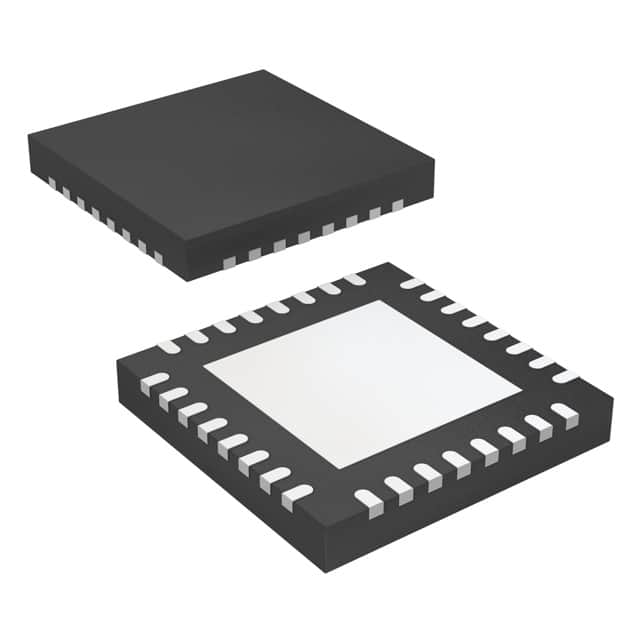DS15BR400TSQX/NOPB
Product Overview
- Category: Integrated Circuit
- Use: High-speed differential signal conditioner and driver
- Characteristics:
- Converts low voltage differential signals (LVDS) to high-speed current mode logic (CML)
- Operates at data rates up to 4.25 Gbps
- Supports various applications including video transmission, data communication, and high-speed interconnects
- Package: 32-pin WQFN package
- Essence: Provides reliable and efficient conversion of LVDS signals to CML signals
- Packaging/Quantity: Available in tape and reel packaging, with a quantity of 2500 units per reel
Specifications
- Operating Voltage: 3.3V
- Operating Temperature Range: -40°C to +85°C
- Data Rate: Up to 4.25 Gbps
- Input Signal Type: LVDS
- Output Signal Type: CML
- Package Type: WQFN
- Package Dimensions: 5mm x 5mm
- Pin Count: 32
Detailed Pin Configuration
- VCC
- GND
- INP
- INN
- NC
- NC
- NC
- NC
- NC
- NC
- NC
- NC
- NC
- NC
- NC
- NC
- NC
- NC
- NC
- NC
- NC
- NC
- NC
- NC
- NC
- NC
- NC
- NC
- OUTN
- OUTP
- NC
- NC
Functional Features
- Converts LVDS signals to CML signals for high-speed data transmission
- Provides low jitter and low power consumption
- Supports various applications including video transmission, data communication, and high-speed interconnects
- Offers excellent signal integrity and noise immunity
Advantages
- High-speed data transmission up to 4.25 Gbps
- Low jitter and low power consumption
- Compact package size for space-constrained designs
- Reliable signal conversion with excellent signal integrity
Disadvantages
- Limited pin configuration options
- Not suitable for applications requiring different signal types or voltage levels
Working Principles
The DS15BR400TSQX/NOPB operates by receiving LVDS input signals on the INP and INN pins. It then converts these signals to high-speed CML output signals on the OUTP and OUTN pins. The device utilizes internal circuitry to amplify and condition the signals while maintaining low jitter and power consumption.
Detailed Application Field Plans
The DS15BR400TSQX/NOPB is widely used in various applications that require high-speed differential signal conditioning and driving. Some of the common application fields include:
- Video Transmission: The IC enables the transmission of high-quality video signals over long distances with minimal signal degradation.
- Data Communication: It facilitates reliable and high-speed data transfer between devices, such as in networking equipment and storage systems.
- High-Speed Interconnects: The DS15BR400TSQX/NOPB is suitable for connecting high-speed components and subsystems, ensuring efficient data transfer.
Alternative Models
- DS15BR401TSQX/NOPB: Similar to DS15BR400TSQX/NOPB but with additional features for enhanced signal conditioning.
- DS15BR402TSQX/NOPB: A higher-speed version of DS15BR400TSQX/NOPB, supporting data rates up to 6.25 Gbps.
- DS15BR403TSQX/NOPB: A lower-speed variant of DS15BR400TSQX/NOPB, designed for applications requiring data rates up to 2.5 Gbps.
(Note: The above alternative models are provided as examples and may not represent an exhaustive list.)
In conclusion, the DS15BR400TSQX/NOPB is a high-speed differential signal conditioner and driver that converts LVDS signals to CML signals. It offers reliable signal conversion, low jitter, and low power consumption, making it suitable for various applications in video transmission, data communication, and high-speed interconnects.
10个与DS15BR400TSQX/NOPB在技术解决方案中的应用相关的常见问题及解答
What is the maximum data rate supported by DS15BR400TSQX/NOPB?
- The maximum data rate supported by DS15BR400TSQX/NOPB is 4.25 Gbps.Can DS15BR400TSQX/NOPB be used for high-speed serial data transmission?
- Yes, DS15BR400TSQX/NOPB is designed for high-speed serial data transmission applications.What is the power supply voltage range for DS15BR400TSQX/NOPB?
- The power supply voltage range for DS15BR400TSQX/NOPB is 3.0V to 3.6V.Does DS15BR400TSQX/NOPB support AC-coupled and DC-coupled applications?
- Yes, DS15BR400TSQX/NOPB supports both AC-coupled and DC-coupled applications.Is DS15BR400TSQX/NOPB suitable for use in industrial environments?
- Yes, DS15BR400TSQX/NOPB is suitable for use in industrial environments with its robust design.What is the typical power consumption of DS15BR400TSQX/NOPB?
- The typical power consumption of DS15BR400TSQX/NOPB is 250mW per channel.Can DS15BR400TSQX/NOPB be used for clock and data recovery (CDR) applications?
- Yes, DS15BR400TSQX/NOPB can be used for clock and data recovery (CDR) applications.Does DS15BR400TSQX/NOPB support spread spectrum clocking (SSC)?
- Yes, DS15BR400TSQX/NOPB supports spread spectrum clocking (SSC) for reduced EMI.What is the input common-mode voltage range for DS15BR400TSQX/NOPB?
- The input common-mode voltage range for DS15BR400TSQX/NOPB is -1V to 2V.Is DS15BR400TSQX/NOPB compatible with other differential signaling devices?
- Yes, DS15BR400TSQX/NOPB is compatible with other differential signaling devices, making it versatile for various technical solutions.


